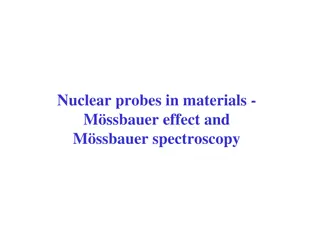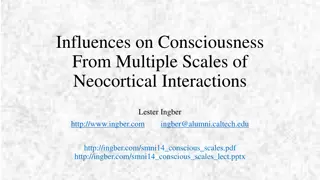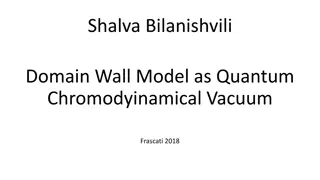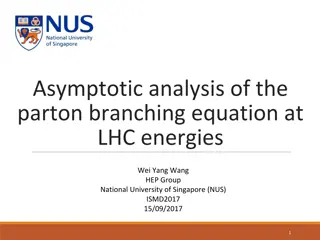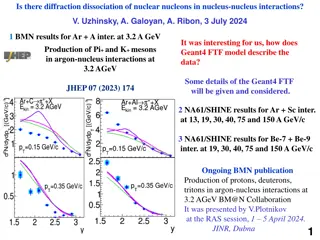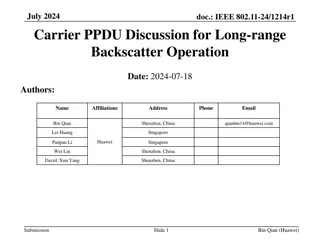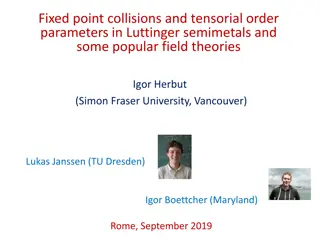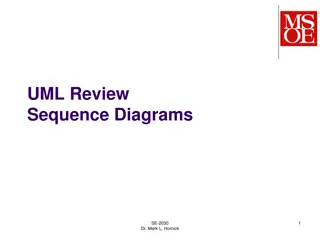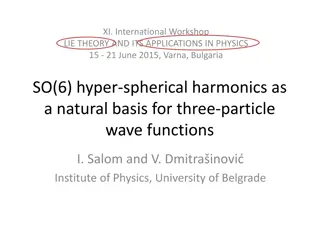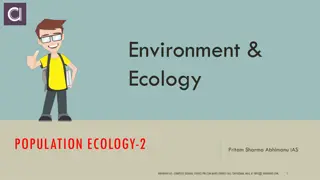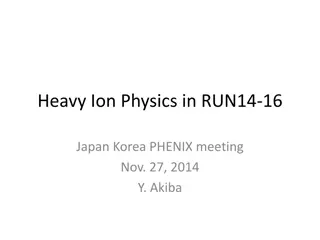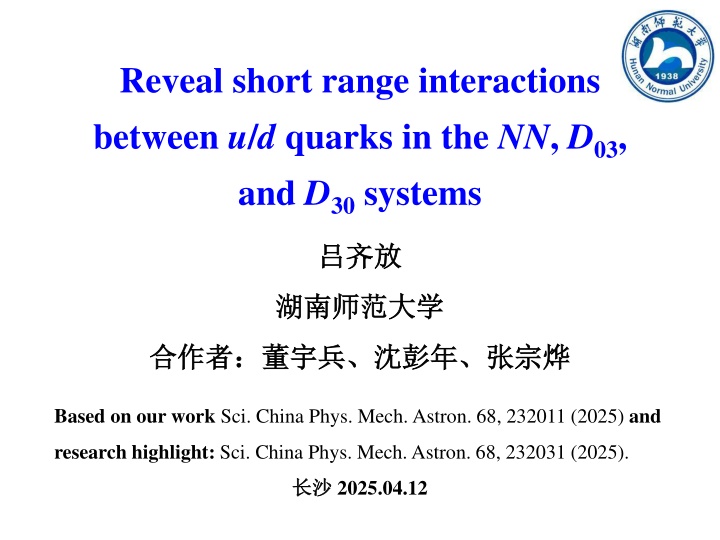
Revealing Short-Range Interactions in Quark Systems Based on Recent Research
Explore short-range interactions among u/d quarks in NN, D03, and D30 systems, examining conventional baryons, exotic states, and experimental observations of nonstrange dibaryons like d*(2380). Discover the intriguing world of particle physics.
Download Presentation

Please find below an Image/Link to download the presentation.
The content on the website is provided AS IS for your information and personal use only. It may not be sold, licensed, or shared on other websites without obtaining consent from the author. If you encounter any issues during the download, it is possible that the publisher has removed the file from their server.
You are allowed to download the files provided on this website for personal or commercial use, subject to the condition that they are used lawfully. All files are the property of their respective owners.
The content on the website is provided AS IS for your information and personal use only. It may not be sold, licensed, or shared on other websites without obtaining consent from the author.
E N D
Presentation Transcript
Reveal short range interactions between u/d quarks in the NN, D03, and D30systems Based on our work Sci. China Phys. Mech. Astron. 68, 232011 (2025) and research highlight: Sci. China Phys. Mech. Astron. 68, 232031 (2025). 2025.04.12
Outline Background Model and method Results and discussions Summary
Conventional baryons Conventional baryons S. Navas et al. (Particle Data Group), Phys. Rev. D 110, 030001 (2024) 3/28
Exotic states In addition to the conventional states, QCD also permits the existence of other types of hadrons, known as exotic states. Some tetraquark candidates observed recently X(6900), X(2900), Zcs(3985), Zcs(4000), Tcc(3875) ... 4/28
Nonstrange dibaryon sextet Nonstrange dibaryons D01 BB Threshold (MeV) 1878 Particle/Candi date Deuteron Binding energy NN 2.2 MeV D10 NN 1878 A virtual state 67 keV D12 N 2171 Evidence UN D21 N 2171 Evidence UN D03 d*(2380) 2464 ~80 MeV D30 2464 No signal UN 5/28
Experimental observation of d*(2380) P. Adlarson, et al. [WASA-at-COSY Collaboration], Phys. Rev. Lett. 106, 242302 (2011). 6/28
Experimental observation of d*(2380) P. Adlarson, et al. [WASA-at-COSY Collaboration], Phys. Lett. B 721, 229 (2013). 7/28
Experimental observation of d*(2380) Analysing power data and Argand diagram P. Adlarson et al., Phys. Rev. Lett. 112, 202301 (2014). R. L. Workman, W. J. Briscoe and I. I. Strakovsky, Phys. Rev. C 93, 045201 (2016); Phys. Rev. C 94, 065203 (2016). P. Adlarson et al., Phys. Rev. C 90, 035204 (2014). 8/28
Experimental observation of d*(2380) Channels: pn d , pd 3He , dd 4He , pn pn ... Binding energy : 80 MeV below the threshold. A large binding energy suggests that it has a small size, which may be compact. Total width: 70 MeV. A small width compared with baryon. 9/28
Notations and references We use symbol D to represent the dibaryon. DIJ is used to denote the isospin I and spin J. The d*(2380) is a good candidate of the D03 state. Many theoretical and experimental works exist. Some recent reviews Y. Dong, P. Shen and Z. Zhang, Prog. Part. Nucl. Phys. 131, 104045 (2023). L. Dai, Y. Wang, L. Chen and T. Zhang, Symmetry 15, 446 (2023). M Bashkanov et al, J. Phys. G: Nucl. Part. Phys. 51, 045106 (2024). 10/28
A long-standing problem in the quark models One gluon exchange or vector meson exchange, which one dominates the short range interactions between light quarks? Which systems are suitable for investigating this problem? Our proposal: investigating the NN, D03, and D30systems jointly in the extended chiral SU(3) quark models 12/28
The extended chiral quark models Chiral quark model: OGE, confinement, pseudoscalar and scalar mesons Extended chiral quark model: extra vector meson exchanges L. R. Dai, Z. Y. Zhang, Y. W. Yu and P. Wang, Nucl. Phys.A727, 321-332 (2003). F. Huang, P. N. Shen, Y. B. Dong and Z. Y. Zhang, Sci. China Phys. Mech.Astron. 59, 622002 (2016). 13/28
Wave functions for D03 Solving the RGM equation to obtain the mass of a dibaryon. 15/28
Results for NN scattering phase shifts NN scattering phase shifts. Other higher partial waves can be also described well. Insensitive to the short range interactions. 16/28
Results for D03[d*(2380)] and D30 Wave functions of D03[d*(2380)] and D30 Not only the colorless , but also hidden color components. 17/28
Results for D03[d*(2380)] and D30 Vector meson exchange is essential for the correct binding energies Compact nature of the D03state The D30state is a weekly bound state (about 5~12 MeV) 18/28
Short range interactions between light quarks The deuteron cannot help us to distinguish the short range interaction, since it is a loosely bound state. The results of D03and D30states indicate that the vector meson exchange interactions dominate the short range interactions. The small residual one gluon exchange coupling strength is also allowed. Our work: Q. F. L , Y. B. Dong, P. N. Shen and Z. Y. Zhang, Sci. China Phys. Mech. Astron. 68, 232011 (2025). Research Highlight: B. S. Zong, Sci. China Phys. Mech. Astron. 68, 232031 (2025). 19/28
More evidence from other works The empiric vector dominance for the interactions between hadrons containing light quarks at the hadron level. Vector meson exchange can improve the description of meson and baryon spectra. X. K. Dong, F. K. Guo, B. S. Zou, Commun. Theor. Phys. 73, 125201 (2021). B. R. He, M. Harada and B. S. Zou, Phys. Rev. D 108, 054025 (2023). 20/28
Other problems Why is the binding energy of d*(2380) so large? Large hidden color components exist in the d*(2380). It has a sizable compact core. Quark exchange effects are significant. 21/28
Other problems What about the mirror state D30? The mirror state D30is a weakly bound state. It also has a significant hidden color component. Only S-wave channels exist in this system. No signal of D30is observed until now. (Near threshold?) 22/28
Searching for the D30state Invariant masses for pp and the total cross section. Limited data. P. Adlarson et al. (WASA-at-COSY Collaboration), Phys. Lett. B 762, 455-461 (2016). 23/28
Further investigations Other possible channels for d*(2380): d d , d d , e+e-collisions, decay The D30state can be searched for in the pp pp + + - -reaction Possible nonstrange D12and D21states which are composed of N and hidden color components Systems like NN*(1535), d, and so on Systems with strange, charm, and bottom quarks T. Ishikawa, et al., Phys. Rev. C 104, L052201 (2021); Phys. Rev. C 105, 045201 (2022). 24/28
Symmetry analysis When antisymmetrizer Asfcis large enough, the system is very possible to become a bound state. More systems like ? 25/28
Example of lattice calculations on ccccccsystem Y. Lyu, H. Tong, T. Sugiura, S. Aoki, T. Doi, T. Hatsuda, J. Meng and T. Miyamoto, Phys. Rev. Lett. 127, 072003 (2021). 26/28
Summary The vector meson exchange interactions dominate the short range interactions between light quarks. The d*(2380) is a system with large hidden color component. Predicting the mirror state D30, which is a weakly bound state. Needing more investigations on other systems. More works about spectroscopy for mesons, baryons, tetraquarks, pentaquarks, and hexaquarks can be found in My homepage https://inspirehep.net/authors/1383269 27/28


